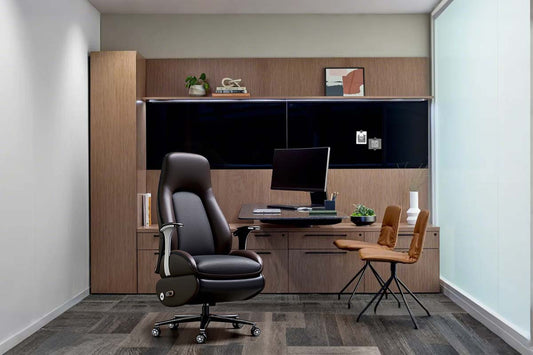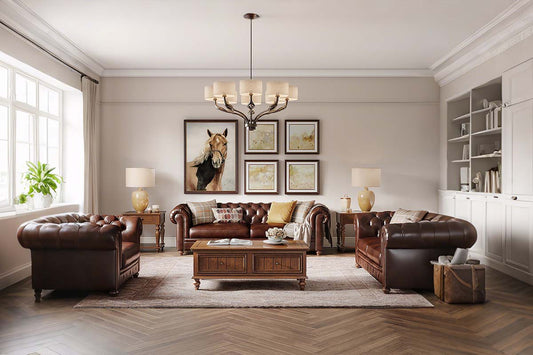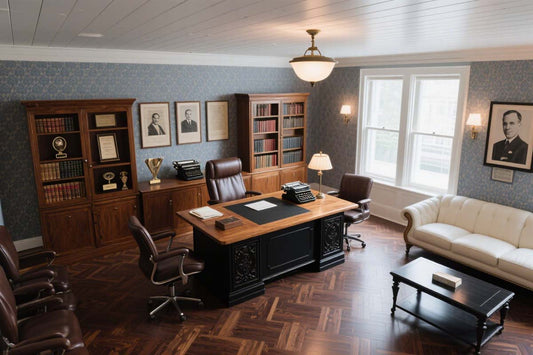
Leather Office Chiar A Sustainable Byproduct of the Beef Industry
Share
When we think about sustainable furniture, leather may not be the first material that comes to mind. In reality, choosing a traceable leather office chair can be a responsible decision. Most of the leather used in high-end furniture comes as a byproduct of the beef industry, not from animals raised for their hides.
Regions such as Tuscany in Italy, Texas in the United States, Chennai in India, and Victoria in Australia are well-known for producing leather under strict environmental tanning standards. These areas have become global hubs for sustainable leather furniture manufacturing.

So if you’re searching for sustainable leather furniture near me, it’s worth paying attention to certified suppliers from these regions—where craftsmanship, quality, and sustainability go hand in hand.
Why do people associate leather office chairs with luxury?
Leather office chairs do carry an image of sophistication and prestige. However, from my over ten years of sourcing materials for POVIMO, I can say the story goes deeper. Leather is not just about luxury—it’s about durability, comfort, and surprisingly, sustainability.

Unlike synthetic furniture fabrics commonly found in North America, Europe, and Australia—such as polyurethane or PVC—genuine leather furniture offers a more sustainable choice, especially for eco-conscious consumers in places like California, Texas, Melbourne, and Germany.
Leather is naturally biodegradable, highly durable, and less frequently replaced, helping reduce the amount of furniture waste sent to local landfills. In countries such as the United States, Australia, and Italy, premium leather furniture is often made from byproducts of the local meat industry, supporting a circular economy and minimizing resource waste.
A well-crafted leather sofa or office chair typically lasts four to five times longer than fabric alternatives. It is also a better option for households with allergy sensitivities, since leather does not trap dust and odors as easily as textiles.
While the initial investment may be higher, from a life cycle assessment (LCA) perspective, leather furniture often proves more cost-effective in the long run. For consumers in cities like London, Sydney, or Vancouver, this means lower replacement and maintenance costs—while simultaneously reducing their overall environmental footprint.
Is leather sustainable? Does leather production harm the environment?
That’s a common misconception. Here’s the truth:
- Byproduct of the beef industry: The vast majority of hides come from cattle already raised for meat. These hides would otherwise go to waste.
- Reducing waste: Transforming hides into office chairs, couches, or other furniture ensures nothing is discarded unnecessarily.
- Circular value chain: Instead of farming animals solely for leather, the industry maximizes existing resources from beef production.
In short, choosing a leather office chair supports a more responsible use of natural resources.
Leather chairs are more comfortable and durable than fabric ones!
- Comfort: Leather adapts to your body shape over time, creating a tailored seating experience.
- Durability: Unlike many fabrics that fray or flatten, leather withstands years of use with grace.
- Investment value: A genuine leather swivel chair or executive desk chair often lasts far longer than its fabric counterpart, making it a smarter long-term purchase.
How versatile is leather in terms of office aesthetics?
Extremely versatile. From classic black leather office chairs that match executive suites to modern tan finishes that fit creative studios, leather blends with both traditional and contemporary décor. Its timeless nature means it never feels outdated—something I’ve consistently seen across markets.
Does the sustainability story cover just chairs or other furniture too?
It definitely extends beyond chairs. Leather couches, lounge chairs, and even accent pieces all share the same benefits: durability, comfort, and sustainable sourcing. That’s why leather has remained a global staple in both offices and homes.
Consider the quality of the leather in office furniture
- Ethical sourcing: Ensure the manufacturer uses hides as byproducts of the beef industry, not from unethical supply chains.
- Eco-friendly tanning: Modern tanning methods can significantly reduce chemical impact.
- Reputation of the brand: At POVIMO, for example, we carefully vet suppliers to guarantee our chairs meet both comfort and sustainability standards.
What’s the real takeaway?
A leather office chair is not just a symbol of luxury—it’s a conscious choice. By utilizing hides that are byproducts of the beef industry, leather furniture transforms potential waste into long-lasting, comfortable, and timeless pieces. For anyone balancing comfort, style, and sustainability, leather remains one of the smartest investments.

Kapoulitsas Anton
From the family workshop to a global brand, Anton founded POVIMO in 2002 at age 19 and has spent decades shaping premium office furniture that balances craftsmanship with sustainability.
Anton’s hands-on journey — visiting factories across the U.S., Europe and Asia and personally evaluating hundreds of chairs and desks — informs POVIMO’s sourcing and product standards. Since 2016 he has built production partnerships and material supply chains across Mainland China, Taiwan, and Australia to ensure quality, traceability, and scalable sustainability.
Anton believes great design should also be responsible design. Under his guidance POVIMO prioritizes hides and materials that are responsibly sourced as byproducts of existing agricultural supply chains, and partners with tanneries and factories that reduce waste and embrace cleaner tanning processes.
Curious about the sustainability details? Read our Q&A: "Sustainability Explained" — a clear, expert-led guide on how leather can be a responsible furniture choice when sourced and processed properly.
- 2002 — POVIMO founded by Anton (age 19).
- 2016 — Strategic sourcing & production partnerships across Asia & Australia.
- Ongoing — In-person factory reviews, product testing, and sustainability audits.



